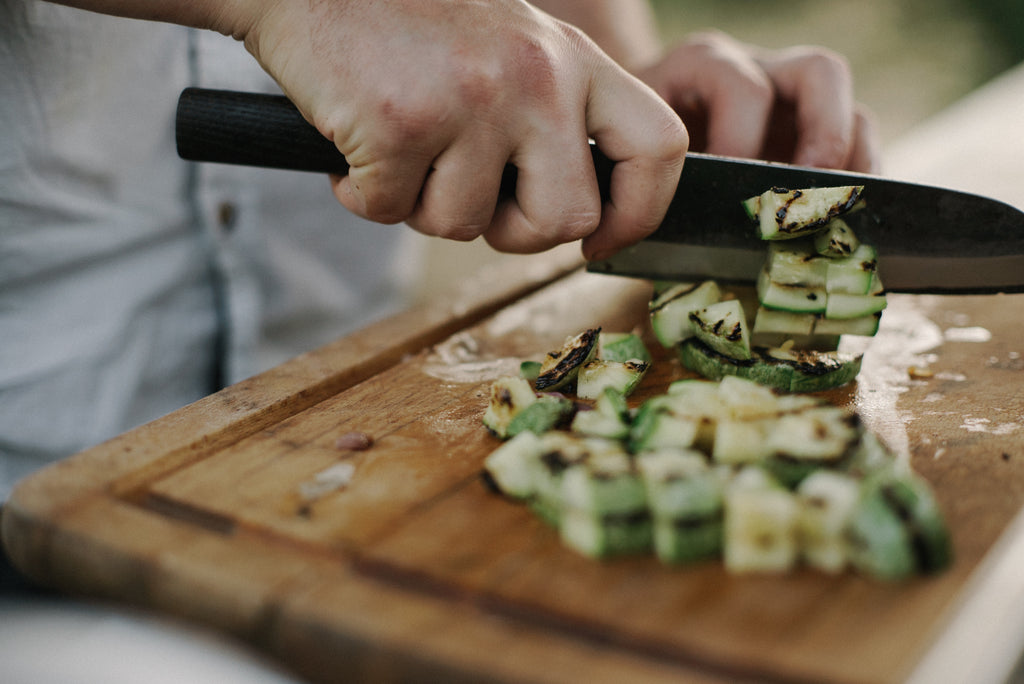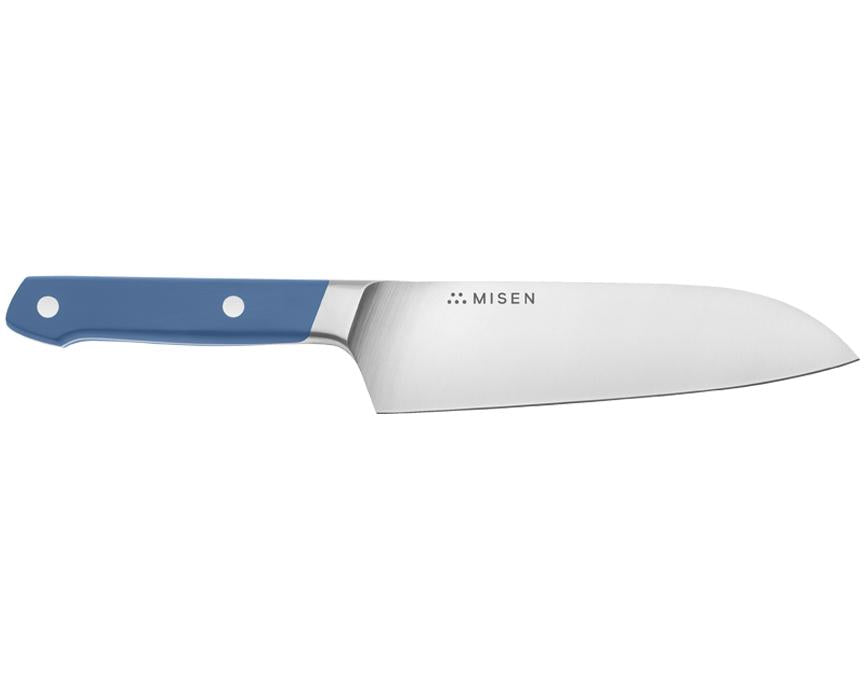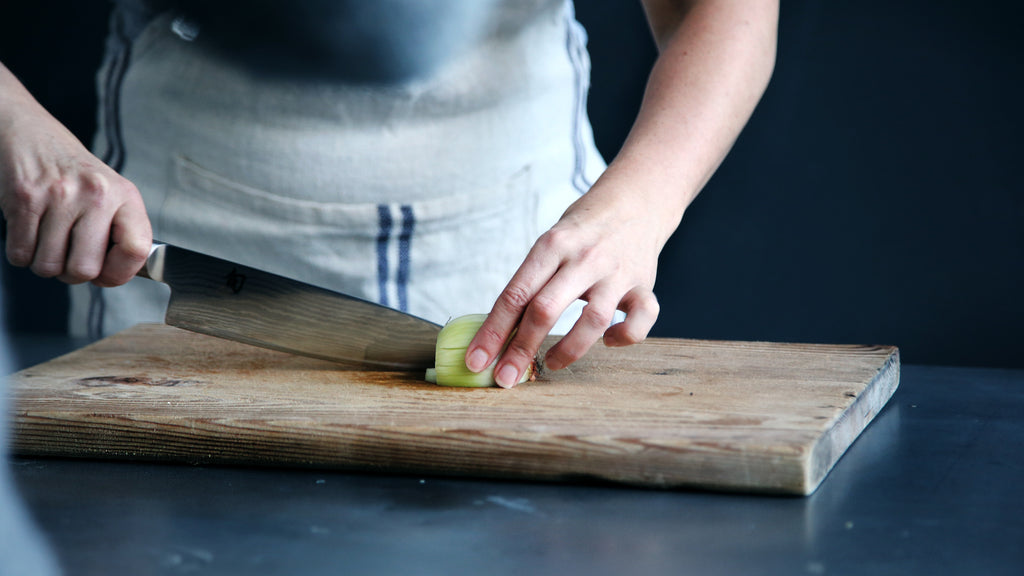What Is a Santoku Knife?
 A chef uses a santoku knife for one of its three virtues: chopping vegetables.
A chef uses a santoku knife for one of its three virtues: chopping vegetables.
- The santoku knife was first created in Japan to be a more user-friendly alternative to the traditional vegetable cleaver.
- Santoku knives are similar to Western-style chef’s knives with a few key differences in size and shape.
- When buying a santoku knife, look for ease-of-use.
What is a santoku knife? This is a question asked by those who've spent a good amount of time in the kitchen: the home cook, the more-than-interested foodie, the one who enjoys scouring grocery aisles and binge-watching Iron Chef.
When most people think of knives, a chef’s knife usually comes to mind. The santoku knife, on the other hand, is its very close — and often mistaken for — younger cousin. A great santoku knife can accomplish a lot of the same tasks as a great chef’s knife.
The History of the Santoku Knife
The story of the santoku knife begins in Japan. Santoku knives first appeared in the mid-20th century, post World War II, as a home cook’s alternative to the traditional vegetable cleaver, called a "nakiri." While retaining the nakiri’s height and straight edge, santoku knives added a friendly “sheep’s foot” tip that curves down toward the edge to form a gentle point.
The Japanese santoku knife is shorter than its Western-style counterparts, ranging from 5–8 inches in length, and is designed with a more balanced weight distribution. The word santoku actually translates to “three virtues” — some say these are meat, fish, and vegetables, while others interpret them to be chopping, slicing, and dicing.
Regardless of which trio you prefer, the santoku knife quickly grew to be the most popular kitchen knife in Japan, and very soon after, found its way into the hands of both home and professional chefs around the world.
Santoku Knives vs. Chef’s Knives
 At Misen, we make both our traditional chef's knife and our santoku knife from high-carbon steel.
At Misen, we make both our traditional chef's knife and our santoku knife from high-carbon steel.
Santoku knives and chef’s knives are so similar that most people assume they’re the same thing. And true enough, both are your essential kitchen workhorse knife, useful for slicing, dicing, mincing, and chopping.
Size
The differences lie in the details. A chef’s knife is slightly longer (at about 8–10 inches) than the standard santoku (at 5–8 inches). To put it into perspective, a santoku knife blade is about the length of the average hand.
It is, therefore, lighter than a chef’s knife, making it less intimidating and easier to handle — especially for chefs with small hands. (Giada de Laurentiis and Rachael Ray are huge fans.)
Shape and Weight
To add the necessary weight needed in a good kitchen knife, santoku knives have a boxier build (remember, they were modeled after the chunky cleaver), which adds the extra weight that a shorter knife would otherwise lack. Japanese steel is also heavier than Western steel, contributing to the knife's nice, hefty hand feel.
The santoku knife has an almost completely straight cutting edge with a less pronounced point. This allows for a clean slice without a pointy tip getting in the way, and minimizes the risk of piercing something unintentionally. Its shape also makes it great for a swift downward chop and most other cutting tasks. But it’s not very good for the fluid rocking motion needed in repetitive slicing.
The chef’s knife with its curved lower blade is much more suitable for this kind of back and forth cutting. It also has a sharper, sword-like point that’s useful when you need to puncture through food items or break open stubborn packaging.
Single or Double Bevel
Another key difference between these knives is the bevel. Bevel is the subtle angle at the bottom of the knife that forms its cutting edge. Basically, the more acute the angle, the easier it is to slice.
Traditional Japanese knives, such as santokus, have a sharper 12–15 degree angle and a single bevel (meaning, the blade is tapered only on one side). Most Western designs, including chef’s knives, have a double-bevel and are usually cut at 20–30 degrees.
At the end of the day, it’s all about being able to cut your ingredients into the proper size for cooking. The santoku knife is naturally built for creating thin slices of meat, seafood, cheese, fruit, and vegetables. These are the finer cuts found in many Japanese dishes. Its wide blade also offers a handy way of scooping food off the cutting board and into a bowl or pan.
Chef’s knives, by contrast, offer a bit more range. Their ability to rock back and forth on a curved blade means you can chop a lot of vegetables quite easily. Having a longer blade and a sharp pointed tip is also useful for disjointing meat and separating chicken parts.
When it comes down to it, with the exception of peeling, slicing bread, or dealing with extra large meat bones, most kitchen tasks can be accomplished with either of these two amazing knives.
What to Look for When Buying a Santoku Knife
 The right santoku knife will make chopping easier.
The right santoku knife will make chopping easier.
Santoku knives are usually made from stainless steel but also come in ceramic or high carbon. At Misen, we opt for high-carbon steel because of its number of long-term benefits: it’s stronger, more durable, and stays sharper longer than other material.
Of course, you’ll have to sharpen the knife eventually — unless your knife comes with a life-time sharpening guarantee like Misen’s do — but out of the box, you’re looking for a properly-sharpened knife that's already in fine cutting form.
A sharp blade is the key to any good kitchen knife. Knives made from high-carbon steel already feature a sharper blade, which is a big help for a kitchen tool that’s used as frequently as a santoku.
That brings us to the final factor: price. Santokus, being an all-around, general-purpose knife, shouldn’t break the bank. A lot of new companies have developed amazing, high-quality kitchen tools for honest prices, and you can easily get a great santoku knife for under $150 — one that will serve its purpose and last for many years to come.








